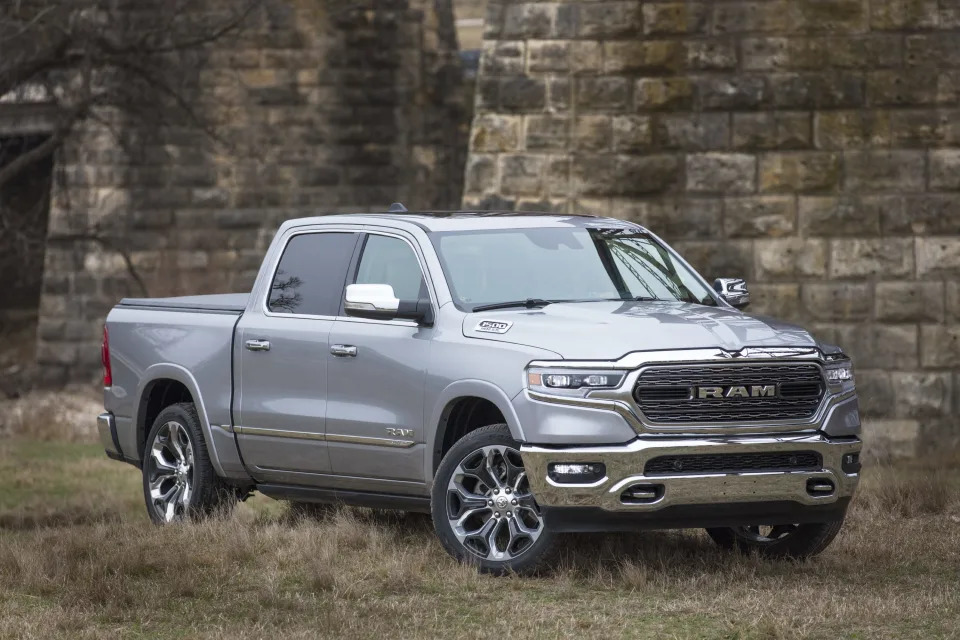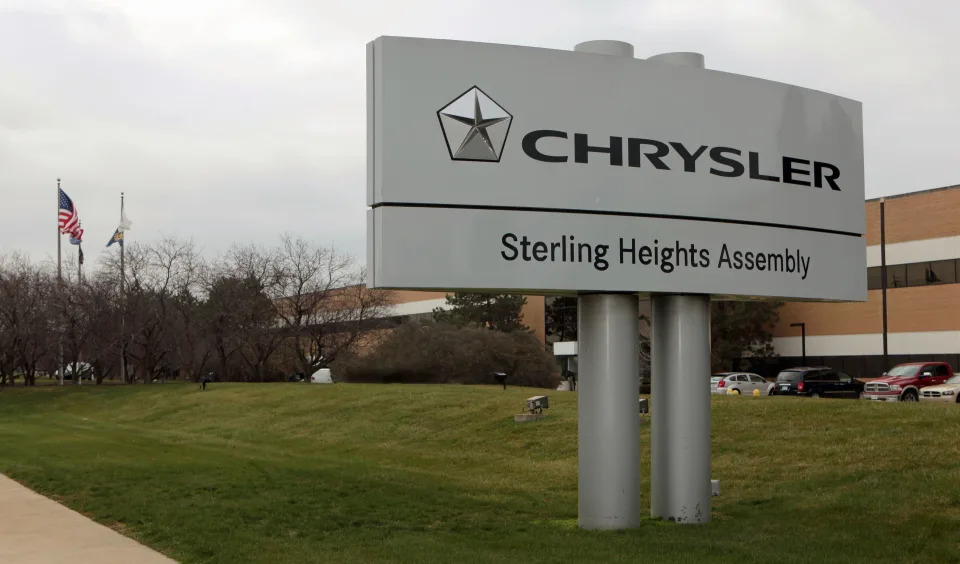Eric D. Lawrence, Detroit Free Press
Tue, August 29, 2023

The Ram 1500 is currently built at Stellantis' Sterling Heights Assembly Plant, but UAW Vice President Rich Boyer says the company wants to move production of the popular truck to Mexico.
UAW Vice President Rich Boyer didn't hold back when he said Stellantis wants to move production of its popular Ram 1500 pickup from Michigan to Mexico.
“That’s an American product. It’s going to stay here in America,” Boyer told a boisterous crowd at a recent union rally tied to ongoing contract negotiations with Ford Motor Co., General Motors and Stellantis.
It's hard to see how any other stance would be welcomed by union members, but a couple of industry watchers said shifting production of the gas-powered Ram 1500 from Sterling Heights Assembly Plant to another location, a point the company hasn't confirmed, wouldn't necessarily have to be the straightforward loss for the union that it appears to be at first blush.
It all depends on negotiations.
The company previously announced that it would build its first electric pickup, the Ram REV 1500, in the United States. If that truck lands at Sterling Heights Assembly Plant, as some assume, it would mean a forward-looking product there that the automaker hopes will sell well, although that would likely introduce a fair amount of uncertainty with EV sales still representing a fraction of the market.
The key is that the issue is being discussed within the framework of bargaining as the automaker, which also owns the Jeep, Chrysler, Dodge and Fiat brands, and the United Auto Workers union try to fashion an agreement to meet a key moment in the monumental transition toward electric vehicles, according to Harley Shaiken, professor emeritus at the University of California, Berkeley.
Shaiken, an expert in both automotive and Mexican labor issues, noted that Mexico has already been playing an expanded role for automakers. Although he described that as problematic for the union in the long run, he also suggested that this isn’t the worst time for the two sides to be discussing the matter.
“What is good for the UAW at this moment is it allows them to address it in the context of the talks,” Shaiken said.
Sam Fiorani, vice president of global vehicle forecasting for AutoForecast Solutions, highlighted how a product change could play out.
More: UAW members practice picketing: As deadline nears, autoworkers are 'ready to strike'
“Stellantis needs all of the capacity they can find for the Ram pickups. The Saltillo (Truck Assembly Plant) has been used for the larger trucks as well as overflow production of the Ram 1500 for years. With the Ram REV coming next year, Sterling Heights will need space to build the new electric truck,” Fiorani said.
Bargaining leverage could be at play in this discussion, but Fiorani indicated that doesn’t mean the situation has to be a loser for either side.
“On the surface, the move does look like a ploy for negotiations with the UAW, but the shift of older product to Mexico has been done in the past. It does leave the door open for the UAW to gain some product and for Stellantis to address some labor and capacity issues. The potential is there for a win-win situation, but both sides are not currently positioned to take advantage of it,” he said.
Talks have been publicly testy, and the prospect of a strike, although not a foregone conclusion, is alive and well. In fact, union members gave a solid thumbs-up when the UAW asked for strike authorization this month.
But even when two sides seem far apart in contract negotiations, prospects for deal-making are possible, as demonstrated by the recent agreement between the Teamsters and UPS.

Sterling Heights Assembly Plant produces Stellantis' popular Ram 1500 pickup.
Shaiken said the fate of the idled Belvidere Assembly Plant in Illinois could play a role under one scenario, if, for instance, Stellantis were to agree to move the gas-powered truck there with the electric truck going to Sterling Heights. It would take “a major push” to do something like that, but it would also address an outstanding issue, Shaiken said.
The company could see a move like that as less costly than the prospect of a strike, he said.
A major perceived disadvantage for workers about trading production of a proven gas-powered vehicle for a new EV would be the size of the workforce.
The prospect that fewer workers will be needed to produce EVs has been a major theme in talking about the transition, although a recent study highlighted by Axios suggested the opposite could be true. Nonetheless, Shaiken said one way the union could address concerns about the need for fewer workers would be to bargain to bring more supplier work into the assembly process, meaning the work would be done by UAW members under the master agreement.
That would be a tough sell, but Shaiken said such things are possible in negotiations.
Whether Stellantis would be open to such scenarios isn’t clear, although the company did highlight the role of the current negotiations in its decision-making.
“Product allocation for our U.S. plants will depend on the outcome of these negotiations as well as a plant’s ability to meet specific performance metrics including improving quality, reducing absenteeism and addressing overall cost. As these decisions are fluid and part of the discussions at the bargaining table, we will not comment further,” according to Stellantis spokeswoman Jodi Tinson.
More: 'We're together in red': UAW members bring the heat to Solidarity Sunday rally
Moving production to Mexico, however, raises a number of issues and fears for U.S. workers.
When he started researching manufacturing in Mexico years ago, Shaiken said he learned that his assumptions about quality and productivity were off target and that in fact both can be higher there than in the United States, partly because plants and machinery are often newer there.
However, pairing those aspects with wages that are a fraction of what U.S. workers make “has resulted in a license to print money for the automakers because these plants have been very successful,” Shaiken said.
That presents a challenge to the UAW. It also highlights the tensions that Boyer gave voice to at the union rally on Aug. 20 in Warren when he said Stellantis CEO Carlos Tavares doesn’t care about “the American autoworker,” using a less polite phrasing for what he said was Tavares’ level of concern.
The Saltillo Truck Assembly Plant in the northern Mexican state of Coahuila currently produces the older version of the Ram 1500 as well as the brand’s heavy duty trucks. The facility, which has more than 4,000 employees, began production in 1995 and built its 4 millionth vehicle, a Ram 2500 Laramie, in 2019, according to the company’s website.
Sterling Heights Assembly Plant, known as SHAP, with more than 5,300 workers, was built as a jet engine plant in 1953 before it shifted to automobile production in the 1980s.
In July 2016, Stellantis predecessor Fiat Chrysler Automobiles announced it would spend $1.49 billion to retool the plant to produce what was then the next-generation Ram 1500 pickup. Mayor Michael Taylor called it the “largest one-time corporate investment in the city’s history,” according to Free Press reporting at the time. That investment came with a tax break “valued at $11.38 million over a 15-year period to help secure the automaker's commitment” and millions of dollars in other potential incentives, according to Free Press reporting.
That plan, part of a larger shift of products, involved changes at multiple plants and was credited with saving jobs in Sterling Heights.
Taylor, on Friday, said he’s aware of the news from Boyer’s announcement, but he hasn’t had any direct conversations with the company or union about the issue. He said he hopes it’s just negotiations and posturing and not a “real serious threat.”
Taylor noted the company invested a lot of money at SHAP, and he said he believes it’s one of the company’s better plants. It also has faced its share of uncertainty in the past, being slated for closure around the time of the Chrysler bankruptcy but seeing an outpouring of support from political leaders at many levels at the time.
“The Ram 1500 is one of the most popular vehicles on the road. Having the (internal combustion engine truck) produced in Sterling Heights is great for Sterling Heights and the surrounding areas, and I think good for Stellantis as well,” he said, noting that “time will tell” on whether EVs become as popular as internal combustion engine vehicles.
Contact Eric D. Lawrence: elawrence@freepress.com.
This article originally appeared on Detroit Free Press: UAW leader: Stellantis wants to move Ram truck production to Mexico
No comments:
Post a Comment